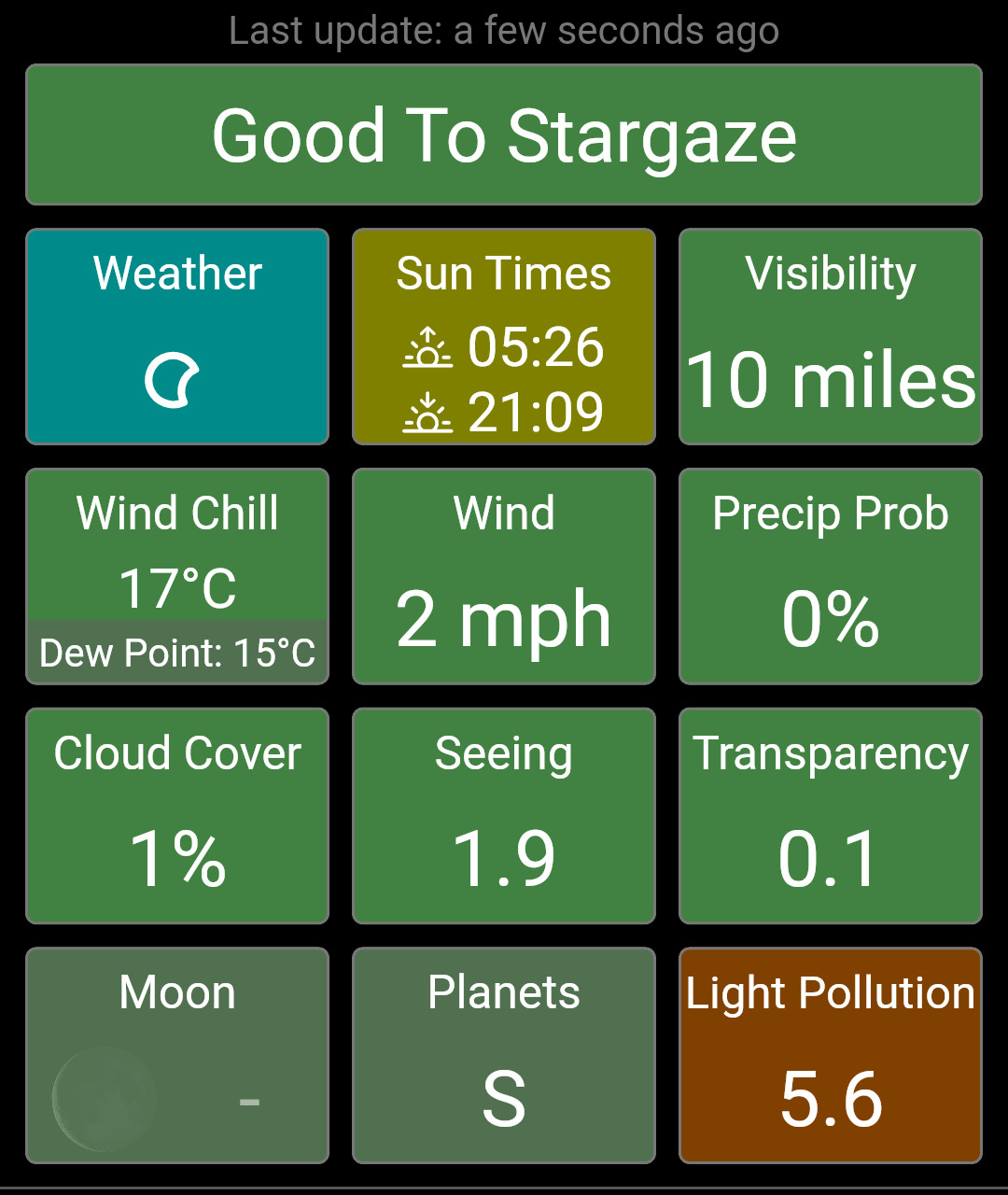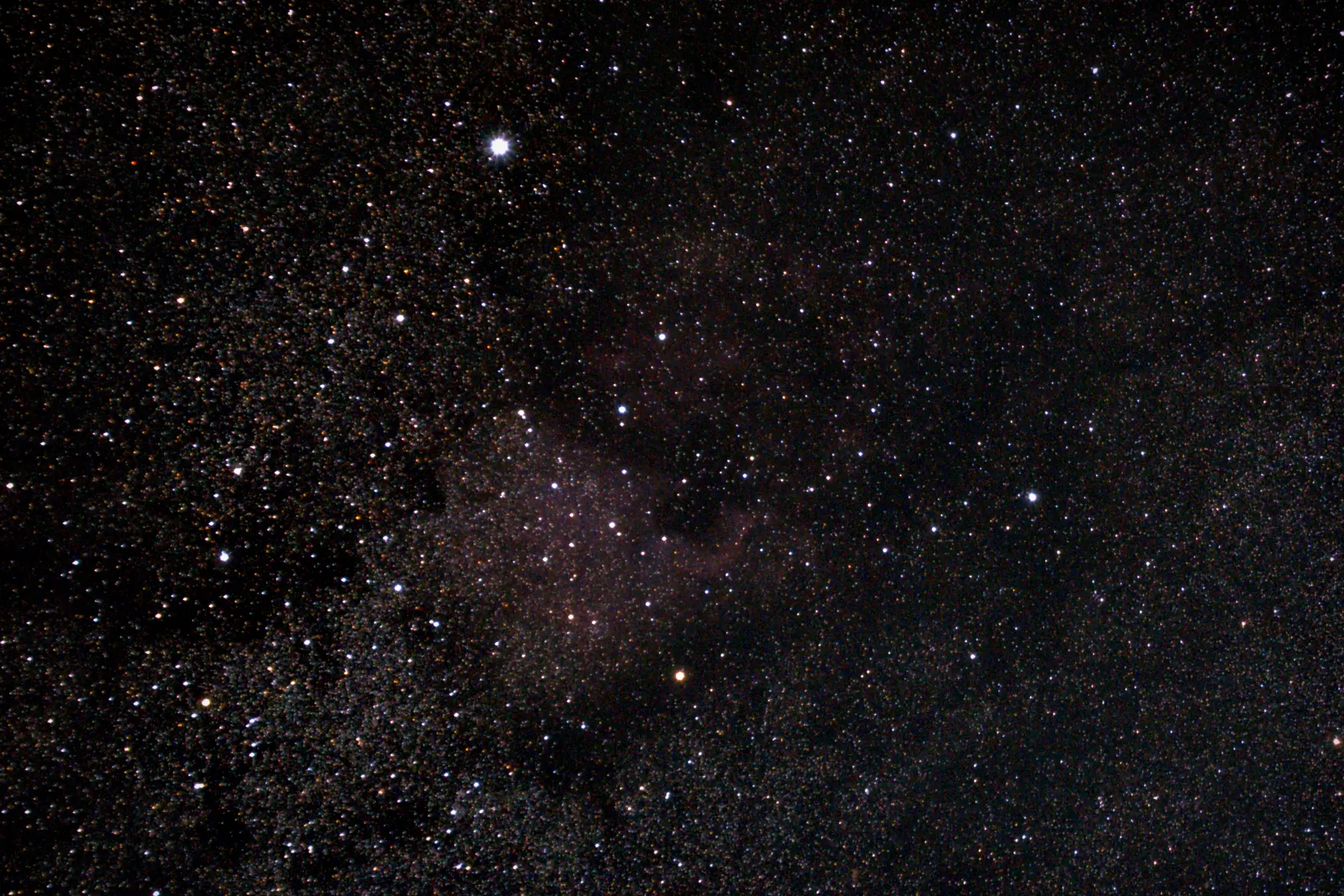This log will not have an accompanying observation report.
Tonight’s target is… You guessed it- The North American Nebula. Tonight, however, I’m feeling good about the chances of taking a leap in quality for what our final product will be.
23:00 – I’m starting late today on my log. As of starting this entry, I’ve already got everything set up, and I’ve been capturing images for around 12 minutes. Here’s a quick run-down of what’s happened so far:
- I set up my new SAM tracker (Yay!).
- Brought my equipment outside.
- Aligned with Polaris (multiple times, as I kept re-aligning after subsequent steps).
- Aimed the Nikon D5600 camera at my target, then focused by using the method of digitally zooming in on the brightest star and adjusting the focus ring until it was as small as possible.
- Connected the Nikon D5600 to the SAM mount via a shutter release cable.
- Slid my dew lens heater onto the camera lens and connected it to power.
- Using the SAM tracker’s software, I’ve then engaged the tracking and done some test exposures.
With all of the above done, I’ve decided to do 60-second exposures at 400 ISO. When trying higher exposure times, I noticed slight trails. This will be due to my alignment not being exactly perfect, but I’m happy to dial it back to 60 seconds.
I tried doing some exposures at 800 ISO like I said I would do in my last attempt. Much to the dismay of my past self, however, I couldn’t commit to it. The pictures were so noisy when zoomed in. As I’m only able to shoot at a maximum of 55mm focal length, my images need to have as little noise as possible so that I can digitally zoom/crop the image to my intended target. The overall image itself is a much wider field than I’m wanting.
I’m nearly at the end of a series of 20 exposures at 60 seconds each. I figured this would give me a good insight as to how sustainable my current alignment and settings are, and it would give me an indication as to how the focus will hold up over time. If that all looks good, I’ll do 2 or 3 runs of 30 exposures at 60 seconds. This should in total come to around 90 minutes of exposure time (well over double any of my other total exposure times).
23:10 – I checked over the 20 exposures and everything looks good. The mount is definitely not perfectly aligned. between frames, there is a slight nudge in the exact position of the stars. While this doesn’t look to be large enough to have any effect on the final images, it indicates that 60-second exposures are a good choice. The reason for this slight ‘miss alignment’ here, I believe, is that I’ve set the tripod up on grass. I think the ground isn’t perfectly level, causing my tracker to not be entirely effective.
I decided tonight that I’d set up on the grass portion of my garden as it’s far removed from the wash of light which comes from my neighbour’s kitchen lights. There were other options, such as not extending the tripod’s legs to their full length so that the light cannot reach the camera from beyond the garden fence, but for the sake of my back, this felt like the better choice. As it is affecting the upper ceiling of my exposure times, however, I might search for other solutions the next time I get everything set up. If I set up the tripod a little earlier I can use the built-in levels to try to fine-tune the leg lengths to allow for it to be balanced.
Tonight is feeling very chilled compared to the previous shoots I’ve done. This is a nice feeling, and it’s something that hasn’t come easy. Essentially, all that’s changed is that my equipment is now doing a lot more heavy lifting than it was previously able to. Before now, I had to align everything in a much cruder way, take short exposures to avoid star trails as I had no tracker, and use the Nikon Android app to remotely and manually take pictures every 10 or so seconds.
With all of the above in mind, tonight’s feeling very nice: I have the SAM tracker keeping everything in frame and taking the pictures for me via a shutter release cable connecting it to the camera, I have a lens heater to prevent the build-up of dew (one less thing to worry about), I have my SAM powered externally instead of via batteries (more on this later), and I’m able to just kind of relax. But yes: I’m still sitting right next to my tripod, even if it doesn’t need me here.
23:20 – My current batch of pictures is due to be completed at 23:40. When we reach that time, I’ll check the pictures that were taken, check the lens has no moisture, check the focus, and then start the next batch if everything looks good to go.
While I wait for that, let’s talk about my SAM mount and the disaster I had last time I used one of these. The SAM mount was a gift from my mum. You can imagine my surprise then when on the first instance using the tracker, it developed a hardware fault: The internal battery contacts compressed and didn’t carry current anymore, killing the tracker halfway through its maiden voyage. I was very upset but, more than anything, worried that I’d done something to ruin this amazing gift I’d only just received.
Thankfully, the retailer swapped it out for a fresh unit. They collected the old one and, after a week or so, the new one had come in. While I don’t think I’ll ever know what actually happened to cause the damage to the old one, I’m beyond thankful to have this new one. The most important thing then is that I intend to learn from my mistakes: AA batteries are not to be trusted. SAM accepts external power from a USB source. Additionally, my new lens heater also requires external USB power. The answer? A battery bank. Tonight, I’ve charged up 2 different 20,000 MAH battery banks (overkill, but I wasn’t sure exactly what would be needed), and I’m powering everything from that.
I think I’ve been out here for around 45 minutes now with the tracker and the lens heater powered via USB, and the battery bank has dropped a grand total of 4%. It’s safe to say that a full evening of taking pictures will not be limited by the powering of the tracker and heater. In fact, the only thing I’ll need to swap out power-wise should be the camera battery. Thankfully, I also have 3 of those.
23:49 – I just finished the next 30 shots and I reviewed them: Everything looks good. I won’t lie, I’m feeling really good about this shoot. Recently I’ve been so excited to just get out and take some pictures that I’ve been going out in less than ideal conditions. The last few shoots I’ve done have had issues with cloud coverage, and this is reflected in the final images.
This is the clearest sky I’ve seen from my garden in a long time. Sadly, the weather reports show that the clear skies aren’t going to last all night. If that were the case, I’d be happy to leave my equipment out overnight. Instead, cloud coverage will start to creep up from 1am onwards. As we reach 4-5am, we’ll then start seeing small (6%~) chances of rain. If there’s one thing I’m not risking, it’s potentially letting my equipment become a victim of the elements.
In this next batch of shots, I’ve queued up 40. This is my third batch, which should total 90 exposures at 60 seconds each (20 + 30 + 40). During the editing process, I could use the best 80%, that’s a total of 72 minutes of exposure time. Depending on how I’m feeling and how the sky’s looking, I might try to push for more, but overall this should be a huge improvement over previous attempts. Before now, I’ve peaked at about 36 minutes of usable exposure time, but none of these were good quality to begin with. I’m looking forward to seeing what type of impact doubling the time will yield.
00:02 – I forgot to note that during my last check of the camera before starting this next batch, I swapped out the battery as the camera was showing it as red. Of my three batteries, the one I had in there was the smallest capacity, and it wasn’t at 100% to start with. I’m expecting the new one I’ve put in to last for the rest of my planned session now.
The other thing I noticed as well is that the case in which I keep my batteries, which were stored on the tripod’s storage tray, was damp to the touch. The camera’s lens, however, was visibly dry. This means that the dew heater ring is doing its job well!
00:33 – I just checked and, sadly, it seems like my focus slowly got progressively worse throughout the last batch. I acknowledge that this is just something that can happen, but I’m really confused as to whether it’s something that I’ve done wrong, or if this is something that is purely out of my hands.
As this has rendered most of the last batch useless, I’ve lined up a few more images, but then I’m going to have to call it.
The next day
I ended up wrapping it up pretty quickly after that last log entry. Essentially, I encountered an issue where the focus was quickly slipping. After only a few shots, the stars would be entirely blurred. I’ve determined this might be due to the dew heater ring twisting the lens’ adjustment dials as the tracker ran. Thankfully, this won’t be an issue next time as my new lens has arrived today, and the design won’t allow for the focus to be meddled with in this way.
The downside here is that even though I had taken almost 100 exposures at 60 seconds a piece, only around 60 are usable. This has meant that my final image, while still leaps and bounds ahead of any of my previous results, isn’t quite where I’d like it to be.
The next step I need to take in improving the quality of my images is just exposure time. I need as much data as possible. If I could have gone for another 3 hours, the final image would have been much better as a result. What I’m trying to say is that I’m excited now for my next good opportunity to get out. Provided it won’t rain, I’ll be doing a full, overnight shoot! Hopefully, it can also be on a weekend, as nobody likes working while they’re running on fumes.
The final image
Camera: Nikon D5600
ISO-Speed: 400
F-stop: f/5.6
Exposure time: 56 minutes (56*60)
Description: The North American Nebula, visibly red, with the fainter portion peaking through to its upper-right.


0 Comments